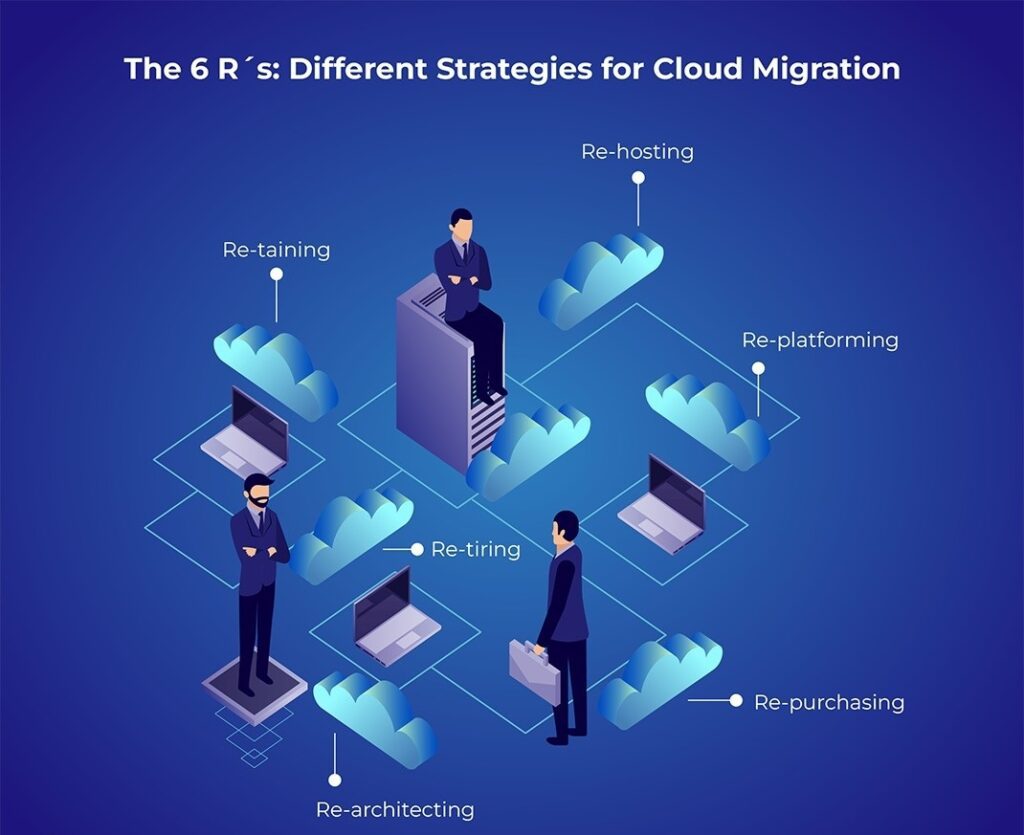
In 2025, cloud migration strategy has emerged as a critical driver of business digital transformation. Organizations worldwide are embracing cloud technologies not only as a means of cutting costs but as an essential lever for technology innovation, cloud scalability, and competitive advantage. As per Grand View Research Report, the global cloud migration strategy services market surged to $16.9 billion in 2024 — with an expected compound annual growth rate (CAGR) of 27.8% through 2030— the urgency to migrate and modernize IT infrastructure continues to accelerate.
The United States alone accounted for $11.75 billion in cloud migration strategy spending last year, reflecting broad adoption across industries including healthcare, finance, retail, logistics, and energy reported by GlobeNews Wire. However, despite increasing investments, many organizations struggle to select the right migration strategy. The variety of cloud migration strategy models available—each with distinct advantages, risks, and operational impacts—make this decision complex but critical.
Cloud migration is no longer a simple technology swap; it is a strategic business decision that impacts cost structures, operational efficiency, speed of technology innovation, and customer experience. The choice of cloud migration model can determine whether organizations achieve sustainable cloud benefits or face spiraling costs and technical debt.
Misaligned migration strategies often cause:
Selecting the most suitable cloud migration model requires a clear understanding of your existing IT landscape, business goals, compliance requirements, and long-term vision. This is where a structured approach, combined with expert guidance, becomes invaluable.
To truly understand how various cloud migration strategy models influence organizational success, it’s important to analyze real-world business challenges and scenarios. This section highlights how carefully chosen migration strategies help overcome obstacles and provides digital transformation narratives that illustrate measurable improvements in performance, cost efficiency, and cloud scalability.

During the COVID-19 crisis, many large healthcare providers turned to rehost (lift-and-shift) migration to move 70% of critical systems from on-premises to the cloud quickly and with minimal changes. This enabled uninterrupted patient care and operational continuity at scale.
But while rehosting offers speed, it can lead to cloud cost overruns if not optimized. Legacy workloads often consume more resources in cloud environments.
By applying cloud cost optimization and FinOps best practices, organizations can eliminate waste, enhance performance, and maintain control over cloud spending.
Nallas helps fine-tune these environments, ensuring your cloud migration strategy delivers real business value—fast, efficient, and scalable.
As Fast-growing logistics startups and data-heavy businesses often turn to replatforming to modernize their database infrastructure. This strategy involves moving legacy systems to managed cloud services boosting processing speed and real-time analytics while keeping core applications intact.
While replatforming improves performance, it comes with challenges like data migration complexity, compatibility issues, and cloud service configuration.
Nallas partners with IT teams to design and execute replatform strategies that minimize disruption and maximize efficiency ensuring smooth integration and hands-on training for a cloud-native environment.
EdTech companies often struggle with scalability during peak times like exam seasons, affecting both student experience and educator productivity. To solve this, many refactor their legacy Learning Management Systems (LMS) into cloud-native architectures—using containerized microservices on platforms like Kubernetes.
This digital transformation enables dynamic scaling, high availability, and faster feature delivery.
Though technically complex—requiring code changes, CI/CD pipelines, and container orchestration refactoring pays off in performance and growth.
With Nallas as your partner, you gain the architectural expertise to transition smoothly into a scalable, resilient, and future-ready LMS.
Some companies running on aging software often gain the most by rebuilding their applications as cloud-native solutions. For instance, many CRM providers have evolved into modern SaaS platforms to remain competitive and meet rising customer expectations.
Rebuilding leverages modern APIs, event-driven architectures, and cloud-managed databases to unlock agility and innovation. However, it requires extensive code rewrites, data migration, and careful attention to business continuity.
With agile, scalable design, organizations can boost feature velocity, streamline integrations, and improve user retention.
Nallas supports end-to-end application rebuilds from design to deployment embedding security, performance, and cloud scalability best practices throughout.
Many organizations—especially in retail—modernize their outdated ERP systems by replacing monolithic applications with SaaS-based ERP solutions. This shift dramatically reduces reporting time, enhances operational visibility, and boosts business agility.
But replacing core systems isn’t without challenges. It involves complex data migration, integration with existing tools, and user adoption hurdles.
Success depends on strong change management, training programs, and seamless integration.
Nallas ensures a smooth SaaS transition—helping you manage data flow, support teams, and unlock the full potential of your SaaS digital transformation.
During a cloud migration strategy, many companies—especially in sectors like energy—identify and retire outdated or redundant applications. This step alone can yield major cloud cost savings in licensing, support, and infrastructure.
By eliminating obsolete systems, IT teams can reduce technical debt and refocus on strategic, value-driven initiatives.
Challenges include application dependencies, data retention rules, and change management. That’s why careful portfolio analysis and stakeholder alignment are critical.
With Nallas Technologies, you gain expert support to assess app value, ensure compliance, and retire legacy systems smoothly—maximizing ROI while minimizing risk.
While cloud adoption promises flexibility and technology innovation, it brings new challenges in cost management. Report reveals that 51% of organizations exceed cloud budgets, and only 42% have full visibility into cloud spending.
Cloud waste typically stems from:
FinOps (Cloud Financial Operations)—financial operations management—bridges IT and finance teams to monitor, analyze, and optimize cloud expenses continuously. Nallas integrates FinOps (Cloud Financial Operations) throughout migration and post-migration phases, empowering clients with real-time cost insights, automated alerts, and governance frameworks. Many clients realize up to 30% cloud cost savings within the first year by eliminating waste and right-sizing resources.
Cloud migration is a multifaceted journey requiring strategic planning, technical expertise, and operational agility. Nallascombines industry knowledge with hands-on experience to guide organizations through every phase:
A recent fintech client’s success story exemplifies this approach. Facing legacy infrastructure challenges and growing data demands, they partnered with Nallas for a phased migration blending replatform for performance enhancementing and refactor for cloud-native scalabilitying. Within six months, they reduced infrastructure costs by 26% and tripled data processing speeds, enabling faster customer onboarding and innovative financial products.
The cloud is no longer a distant ambition but the foundation of modern business. Selecting the right cloud migration strategy model tailored to your unique context is essential to unlock its full potential. Whether rapidly lifting and shifting critical workloads, modernizing legacy applications for scale, rebuild applications for cloud-native architectureing for agility, or retiring redundant systems, each path offers distinct benefits.
With expert partners like Nallasby your side, you can navigate this complex landscape confidently—balancing speed, cost, security, and technology innovation to accelerate your cloud digital transformation and future-proof your business in 2025 and beyond.
Nallas is an IT Consulting and Software Services firm, creating value for every client through effective use of technology, purposeful engagement models, and adaptive methodologies. We provide data, cloud, product, and quality engineering services for enterprises that need to transform with predictability. We partner with our customers on high priority, high visibility projects where failure is not an option.
Q1: What is the best cloud migration model for 2025?
A: The best cloud migration model depends on your business goals.
Expert partners like Nallas can help tailor the right strategy to reduce costs, improve security, and accelerate innovation.
Q2: How does cloud migration reduce IT costs?
A: Cloud migration can reduce IT costs by eliminating hardware maintenance, optimizing resource usage, and shifting to pay-as-you-go pricing. With proper planning and FinOps practices, companies often reduce infrastructure spend by 20–40% annually.
Q3: What is cloud waste and how can FinOps help?
A: Cloud waste refers to unused or underutilized cloud resources that lead to overspending. FinOps (Financial Operations) helps organizations monitor, analyze, and optimize cloud costs through real-time insights, governance frameworks, and cost-control automation.

Lead - Strategy